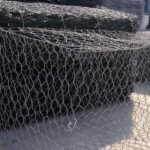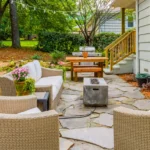Anyone for tennis?
You might enjoy the occasional game on holiday or at your local club, but if you have the space in your back garden it is easier than you might think to have a tennis court built on your property.
This can act as a fantastic focal point for your outdoor space, and set the scene for some fun (and definitely not competitive!) parties.
And what’s more, according to James Cleland of the Knight Frank estate agency, it could also be a useful selling point should you decide to put your home on the market.

“We have plenty of buyers looking for homes with tennis courts,” Cleland commented. “A court can certainly add value, although anyone considering building one should be extremely careful where they position it and be sure they have enough space.”
“Residential Tennis Court” (CC BY 2.0) by MUNSON, INC.
While the benefits speak for themselves, you should remember that there may be some obstacles to overcome before you’re out in the yard serving aces.
You will almost certainly need to secure planning approval from your local authority, due to the change of land use, and there may be additional plans required if your blueprints feature high fencing or lighting. And it might be some time before you’re pulling on your finest tight white shorts too. It can take as long as three months to construct a tennis court from scratch, as foundations need to be dug and the top surface laid before a period of ‘settling’ is allowed.
Typically, the construction work will take place in the winter ready for your court to be christened in the summer. But, as we have already noted, the benefits can certainly outweigh the negatives.
On the Grass

One of the other decisions you will have to make is what type of surface you want your tennis court to have. As you probably know, there are three main types of tennis surface: grass, clay and ‘hard’, such as those used at the Australian and US Opens.
Which you go for will depend on a range of variables from cost and availability to climate, but also how you want to play. Grass is a quicker surface that allows the ball to travel faster, while clay is slower and with a lower bounce. That suits certain players, such as Rafa Nadal, who are able to impart more spin on the ball. The Spaniard is a 12-time winner at Roland Garros – the most famous clay venue – and he is once again the hot favourite in the latest French Open 2020 tennis betting odds.
Of course, it will depend on the weather in your area as to whether you can realistically have a clay tennis court in your garden, although there might be an alternative. Omniclay is a synthetic surface akin to clay, albeit with less maintenance required, and one that can be used in all but the wettest of climates.
Grass is perhaps the most aesthetically-pleasing tennis court surface in the backyard, although again the weather will dictate when you can get a game in. Grass courts require continual maintenance too, from mowing and rolling to weeding and watering.
For most homeowners, hard court surfaces are the smart way to go. These are lower maintenance, and porous – which improves drainage, and allows you to play across more months of the year. If you have been thinking about having a tennis court installed in your garden, hopefully, this guide has been helpful.






